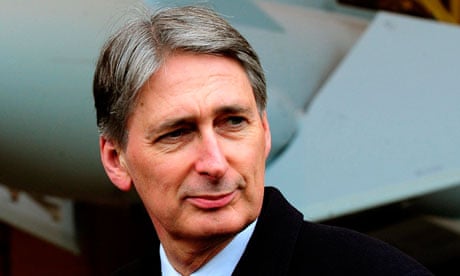The army has axed another 2,900 jobs in the latest cull of the British military amid warnings from the defence secretary, Philip Hammond, that there is "still some way to go" before the redundancy rounds can end.
More than a quarter of those leaving the army in this tranche are being forced out and the Ministry of Defence said on Tuesday it had not yet decided how it could reduce overall numbers to 82,000 – the target demanded by the cuts announced last year.
The RAF and navy have also had to shed staff, though not as many as expected. The air force is to lose 730 personnel, and the navy 170, though both services believe that should be enough to prevent further job losses. The MoD said the total number of people being axed in this round was 3,800.
The cuts to the British military were set out in the 2010 strategic defence and security review, and revised last summer. The navy and the air force were each told to axe 5,000 staff, but the hardest hit was the army, which has to shrink by 19,000 before the end of the decade.
In a speech last week, Hammond hinted that the army faced a major restructuring that is likely to lead battalions being axed, and historic regiments merged. These reforms are expected to be announced shortly, and will have a bearing on how the army will manage the next part of the redundancy programme.
The MoD has stressed that senior officers from all services have not been spared, and that 16% of those leaving the forces in the cuts announced on Tuesday are middle or senior ranks. A full breakdown will not be published for six weeks, but it is thought the army has lost brigadiers and dozens of lieutenant colonels. The navy was looking to axe five commodores and 17 captains, and the RAF needed to cut air commodores and up to 30 group captains.
Ministers have been encouraged that the number of people looking to leave the armed forces voluntarily remains high.
This means the services are making fewer compulsory redundancies than they expected. But in a statement, Hammond conceded there was more pain to come, for the army at least, though he insisted that the mission in Afghanistan would not be affected by the cuts.
"Of course I regret that it has been necessary to make redundancies to deliver our plans for reducing the size of the armed forces. We still have some way to go to bring the size of the army down to 82,000 and decisions on what is necessary to achieve this are yet to be taken, but we won't compromise the mission in Afghanistan."
The numbers of the highest ranking officers in the armed forces are also being cut, though this is being done through a separate programme being undertaken by the MoD's Defence Reform Unit. A
n internal document leaked to the Guardian showed the MoD had become so "top heavy" with senior ranking officers and civil servants that up to 700 posts needed to be cut over the next three years. Full details of the reductions were expected in the spring, and the lack of any announcements has led some in Whitehall to speculate that the top brass will be spared from the worst of the cuts.
The shadow defence minister, Kevan Jones, has insisted senior staff are being protected at the expense of lower ranks.




